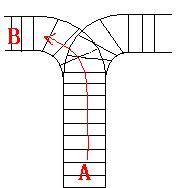【杭电oj】1022 - Train Problem I(栈)
来源:互联网 发布:印刷开单软件 编辑:程序博客网 时间:2024/05/22 10:54
Train Problem I
Time Limit: 2000/1000 MS (Java/Others) Memory Limit: 65536/32768 K (Java/Others)Total Submission(s): 28971 Accepted Submission(s): 10987
Problem Description
As the new term comes, the Ignatius Train Station is very busy nowadays. A lot of student want to get back to school by train(because the trains in the Ignatius Train Station is the fastest all over the world ^v^). But here comes a problem, there is only one railway where all the trains stop. So all the trains come in from one side and get out from the other side. For this problem, if train A gets into the railway first, and then train B gets into the railway before train A leaves, train A can't leave until train B leaves. The pictures below figure out the problem. Now the problem for you is, there are at most 9 trains in the station, all the trains has an ID(numbered from 1 to n), the trains get into the railway in an order O1, your task is to determine whether the trains can get out in an order O2.






Input
The input contains several test cases. Each test case consists of an integer, the number of trains, and two strings, the order of the trains come in:O1, and the order of the trains leave:O2. The input is terminated by the end of file. More details in the Sample Input.
Output
The output contains a string "No." if you can't exchange O2 to O1, or you should output a line contains "Yes.", and then output your way in exchanging the order(you should output "in" for a train getting into the railway, and "out" for a train getting out of the railway). Print a line contains "FINISH" after each test case. More details in the Sample Output.
Sample Input
3 123 3213 123 312
Sample Output
Yes.inininoutoutoutFINISHNo.FINISHFor the first Sample Input, we let train 1 get in, then train 2 and train 3.So now train 3 is at the top of the railway, so train 3 can leave first, then train 2 and train 1.In the second Sample input, we should let train 3 leave first, so we have to let train 1 get in, then train 2 and train 3.Now we can let train 3 leave.But after that we can't let train 1 leave before train 2, because train 2 is at the top of the railway at the moment.So we output "No.".HintHint
Author
Ignatius.L
这道题只需要把火车出入的细节处理好,别把自己绕晕就好做了。
说说我的思路:
1.这道题操作只有两种,进栈和出栈,如果待入栈火车和最顶目标相同的话,那就进入、出去两个连续的步骤。
2.如果不同,那就考虑栈顶元素和最顶目标是否相同,如果相同,则栈顶元素出栈。
3.如果进行到这一步,就表示这一轮没有火车可以出栈了,则压入一节火车,进行下一轮对比。但是这里要注意思考:是否还有待入栈火车,如果没有的话,则gameover,标记并跳出循环。
上面的过程记录一下,最后分情况输出就行啦。
代码如下:
#include <cstdio>#include <queue>#include <stack>#include <algorithm>using namespace std;int main(){int n;char o1[22],o2[22];int op[22],num;//记录操作, 1为入,0为出 bool ans; while (~scanf ("%d",&n)){getchar();scanf ("%s %s",o1,o2);stack<char>s;num=1;ans=true;int x=0;//对o1数组的操作 for (int i=0;i<n;i++){if (o1[x]==o2[i]){op[num++]=1;op[num++]=0;//如果最顶目标相同,则一出一入并记录x++;//对下一节判断 }else if (!s.empty() && o2[i]==s.top()){s.pop();op[num++]=0;}else if (x<=n)//如果没有可以出去的火车且入站口有车,则继续进入并记录 {s.push(o1[x++]);op[num++]=1;i--;}else{ans=false;break;}}if (ans)//分情况输出 {printf ("Yes.\n");for (int i=1;i<=n*2;i++){if (op[i])//若op为1,则输出inprintf ("in\n");elseprintf ("out\n");}printf ("FINISH\n");}else{printf ("No.\nFINISH\n");}}return 0;} 0 0
- 【杭电oj】1022 - Train Problem I(栈)
- 【杭电-oj】-1022-Train Problem I (栈,好)
- 杭电OJ 1022:Train Problem I
- 杭电OJ--1021 Train Problem I
- 杭电1022 Train Problem I(栈)
- 杭电ACM OJ 1022 Train Problem I 回溯法求出栈遍历序列 很强大
- 杭电1022 Train Problem I
- 【ACM】杭电1022:Train Problem I
- 杭电1022-Train Problem I
- 杭电1022 Train Problem I
- 杭电ACM 1022 Train Problem I
- 杭电1022 Train Problem I
- 杭电1022 Train Problem I
- 【杭电】[1022]Train Problem I
- 杭电hdu 1022 Train Problem I 栈
- 杭电Train Problem I
- Train Problem I(杭电1022)(栈的应用)
- 杭电1022——Train Problem I(栈的应用)
- 42-44组合模式
- Hdu 1068 Girls and Boys【最大匹配】
- 我的收藏集
- Android JSBridge的原理与实现 (prompt和javascript)
- AngularJS自定义指令
- 【杭电oj】1022 - Train Problem I(栈)
- 面试中的C++常见问题
- SharePoint2010 IT Professional - 如何在Site Collection内实现Break Permission Level?
- WebWorker
- 自定义线程池ThreadPoolExecutor
- 有iframe的情况下获取元素
- C/C++冒泡排序,然后二分法搜索寻值
- 2016宏病毒分析及预防报告(1-2月)
- 153. Find Minimum in Rotated Sorted Array


